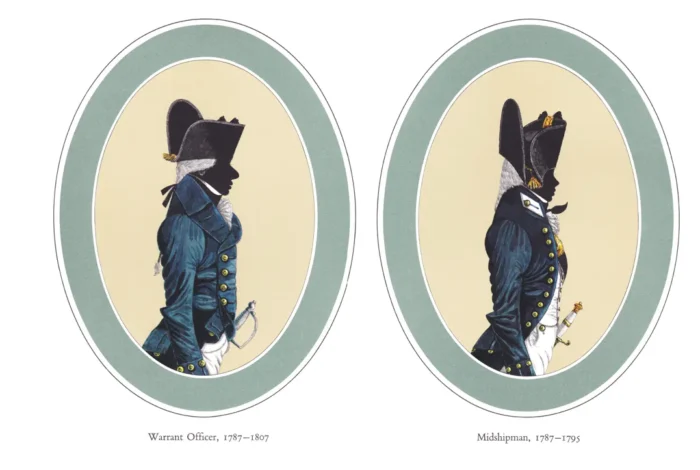Warrant Officer and Midshipman
£20.00
Warrant Officer, 1787-1807
Midshipman, 1787-1795
Published 1965 © Hugh Evelyn Limited; artist John Mollo (1931-2017).
c. 38 x 25 cm. (15″ x 10″) on high white heavy cardstock 149 g/sm².
Shown here is a scan of the print.
This is a STANDARD sized print; see mail costs at Shipping & Returns.
More detail below
In stock
- Satisfaction Guaranteed
- No Hassle Refunds (see Shipping and returns)
- Secure Payments
Description
I. Warrant Officer, 1787-1807:RN officers were divided into two categories – Military and civil, or fighting and administrative. Military comprised flag officers, captains, commanders and lieutenants who held their positions by authority from the Sovereign having been ‘commissioned’. The remainder were appointed by warrant from Admiralty departments. These were ‘Warrant Officers’. First came the master, appointed by the Navy Board, responsible for the technical side of sailing a ship and instructing junior officers in navigation. Next the surgeon, appointed by the Sick and Hurt office, then the purser, appointed by the Victualling Office, responsible for the ship’s stores, food and pay. All three were ‘warrant officers of wardroom rank’, but not quite gentlemen. Their assistants were ‘master’s mates’.
II. Midshipman, 1787-1795: Midshipmen came into neither of the two categories discussed in the last note. In theory they were not officers at all, but ‘young gentlemen’, sometimes of incredibly tender years, who were placed by their parents or guardians under the wing of some naval captain of their acquaintance to learn the profession. This was in practice the only way of eventually qualifying for a commission. Although junior to the master’s mates with whom they shared the gunroom, they were treated as officers in that they were given small commands like a group of guns, or one of the ship’s boats. Their title derives from the fact that their berth was originally amidships on the gun decks, where they were always at hand to carry messages or assist with the distribution of ammunition.
Additional information
| Dimensions | 38 × 25.5 cm |
|---|




